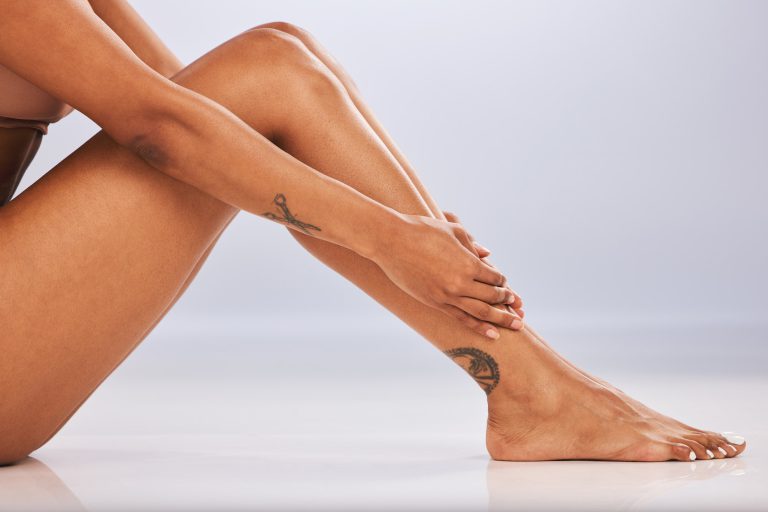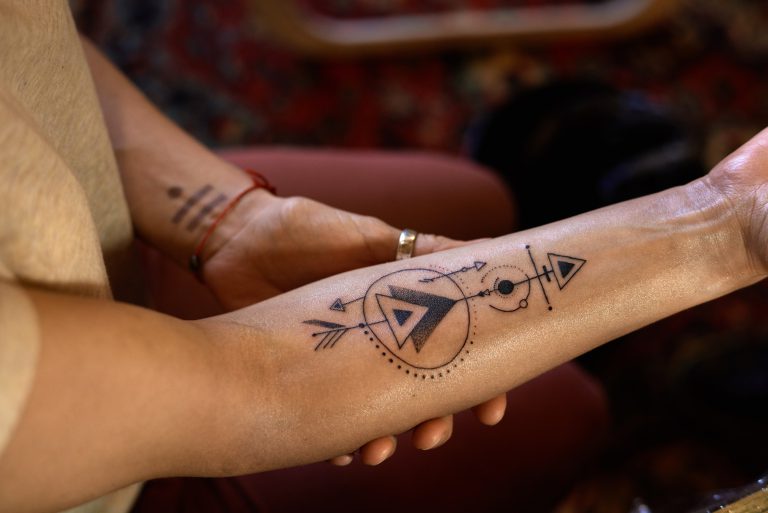In our visually driven culture, tattoos have become a prevalent form of self-expression. However, as with any decision, sometimes regret follows. Whether it’s an impulsive decision of youth, an old flame’s name, or simply a design that no longer resonates, many people are seeking ways to erase their inked past. Enter the world of laser tattoo removal – a safe and effective solution to wipe away the unwanted remnants of old decisions.
Key Takeaways
Laser tattoo removal is a customized process facilitated by advanced laser technologies such as Picosecond lasers, which effectively break down a wide range of tattoo ink colors, making previously difficult to remove colors like reds, yellows, and oranges more manageable.
Post-treatment care is essential for effective healing after laser tattoo removal, including immediate aftercare with antibiotic ointment and Aloe Vera gel, as well as long-term skincare with sunblock and careful maintenance to reduce the risk of scarring or discoloration.
The completeness of tattoo removal varies per individual and is influenced by factors like tattoo color, pigment depth, and the body’s response to the procedure, while evolving technologies like picosecond lasers and non-invasive methods are making removal more effective and less discomforting.
Understanding Laser Tattoo Removal
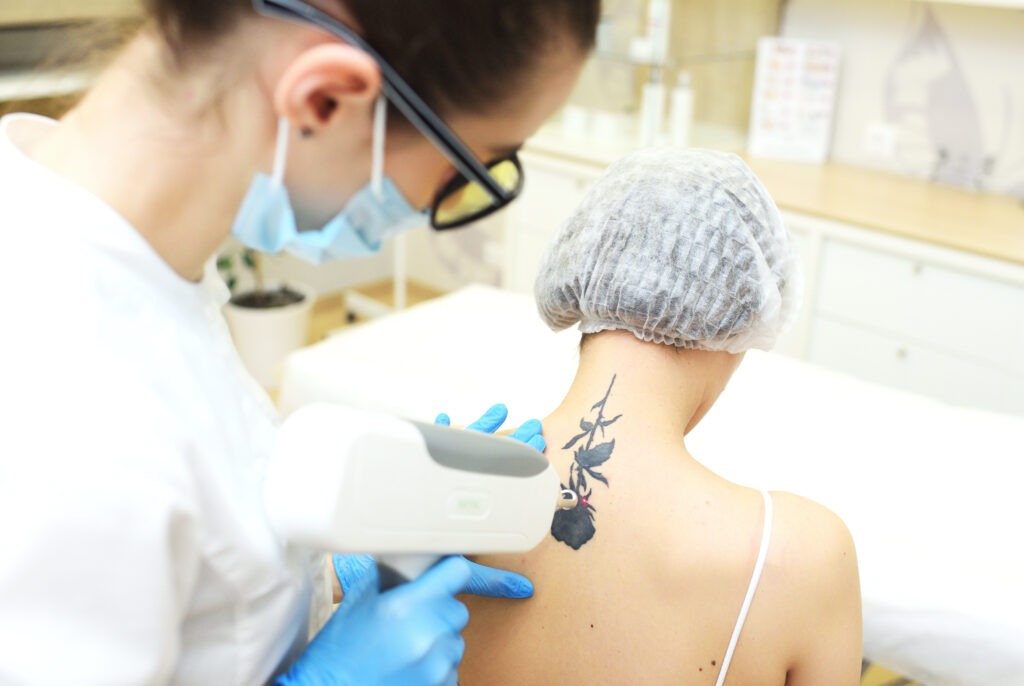
Laser tattoo removal is a special process requiring an expert. In this procedure, trained physicians evaluate the unwanted tattoo to devise a treatment plan based on factors such as ink type, color and pigment depth. Due to advanced lasers that can treat various colored inks including reds, yellows and oranges, better outcomes are now achievable with laser tattoo removal sessions. To gain insight into how it works – which makes possible what was once thought of as unchangeable – let’s look at the science behind this impressive technique.
The Science Behind Laser Treatments
Tattoo removal is a highly sought-after treatment, and one of the most popular options to achieve this is laser tattoo removals. The science behind it lies in laser energy and its ability to target and eliminate pigments from tattoos through breaking them down into ink particles small enough for absorption by the body’s immune system or lymphatic system – significantly expediting this process with lasers set at high intensities.
This approach leverages laser technology differently than other existing tattoo removal methods such as creams, allowing it to fragment ink so that users can naturally expel these smaller pieces easier. It basically acts like a catalyst which breaks down pigment within a tattoo before being expelled out of your body leaving no trace beyond healed skin where there was once an etched design from dye applied under your epidermis layer previously known as ‘ink’.
Laser treatments have become more prominent due to their effectiveness compared to traditional forms used over time when looking at any type or scale of facial artistic expressions / adornment released back onto unmarked flesh canvas surface – making them especially preferable choices among those wanting true freedom while restoring non-traditional artwork returned on their own anatomy cleanly.
Types of Lasers Used in Tattoo Removal
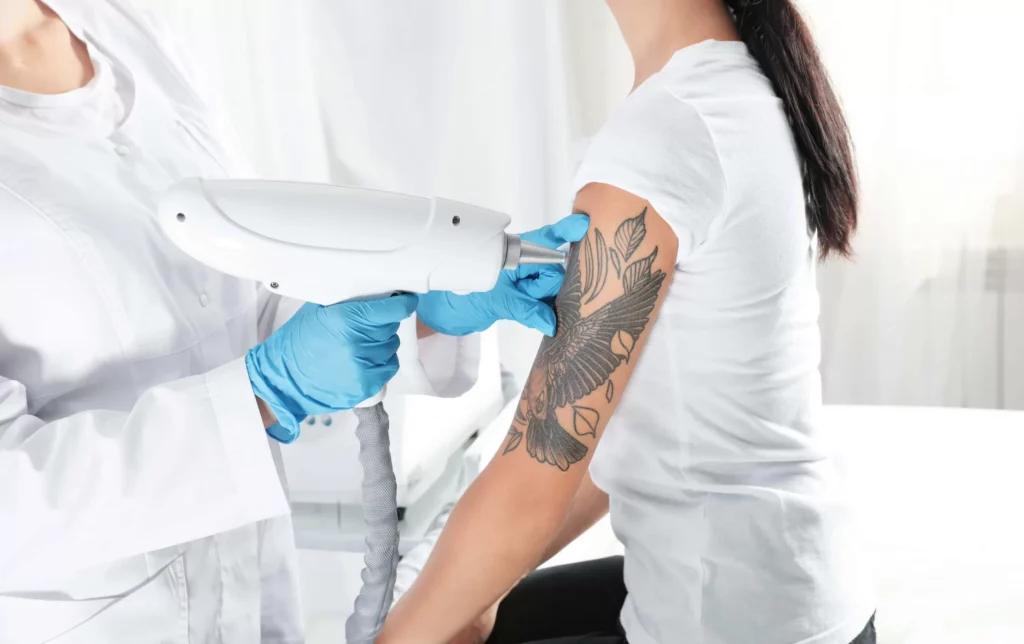
When it comes to laser tattoo removal, there are significant differences between the latest technology and more traditional treatments. Picosecond lasers such as PicoSure and PicoWay have completely changed the game when it comes to removing tattoos, enabling these devices to obliterate ink particles faster while minimizing damage done to the surrounding tissue and skin tissues.
In order for successful results during a tattoo removal procedure, choosing an appropriate wavelength of laser light is important based on what type of color has been used, 1064 nm specifically works best against black pigments whereas 785 nm is usually applied for green hues. All this ties into how modern picosecond lasers make great strides towards effectively eliminating even hard-to-remove tattoos.
Safety Measures and Comfort During Treatment
When it comes to the safety and comfort of laser and tattoo removal treatments, people have many concerns. But, there is no need to worry – as long as treatment is done by a professional specialist in this field, there are usually no significant issues associated with the procedure. Common side effects like blisters and scabs may be experienced, but these cases tend not to occur frequently among patients. Pain tolerance during treatment will depend on one’s individual threshold. Nevertheless, pain management such as local or injectable anesthesia can help ensure maximum ease during each session.
Customizing Your Laser Tattoo Removal Experience

Tailoring a laser tattoo removal treatment plan for optimal outcomes is essential, as no two tattoos are the same. Taking into consideration size, color, location and age of the tattoo along with individual’s skin type helps to create this personalized approach. Skin type plays an important role in how well it will respond to treatment due to factors like melanin levels, skin thickness and interaction between pigment from the tattoo and its surroundings areas with lasers used during therapy sessions. Formulating a customized regimen that takes all these variables can deliver better results when getting rid of unwanted ink!
Creating a Personalized Treatment Plan
When formulating a tailored plan, several aspects are taken into consideration. These include: skin tone, ink type and quality, as well as the skill of the tattoo artist and where it is placed on one’s body. For example, size can have an immense impact upon laser removal process with bigger tattoos taking more time to get rid off which leads to higher expenses in terms of treatments needed for complete elimination. Color also plays its part since darker hues such as black or blue tend to fade away quicker than those light like yellow or white, requiring many sessions before completely eradicating them from one’s skin surface area. Finally, position has an effect too because some sites may contain high concentrations of lymph nodes & blood cells that respond differently when applying this particular tattoo removal method.
Estimating the Number of Sessions Required
When trying to determine the amount of sessions needed for complete tattoo removal, certain factors must be taken into account. These include size, color and age of the respective tattoo. Speaking, larger tattoos usually require more time in order to achieve full eradication.
The hue of a given tattoo can also play an important role when deciding on how many sessions are necessary. Lighter colors like fluorescent pigments bring about extra difficulty that might lead to requiring additional treatment times. Older designs tend to remain deeper within the skin tissue thus meaning that it may take longer than anticipated before being removed entirely from said area.
Does Laser Tattoo Removal Hurt?
One frequently asked question is if laser tattoo removal causes pain. The answer to this inquiry is that although there could be some discomfort similar in level to the sensation felt when getting a tattoo, everyone experiences it differently and various elements like size of ink or area can have an effect on the amount of suffering one might endure. Pain alleviation techniques are available for greater comfort during procedure while taking into account sensitivity associated with certain body parts such as the location of tattoos.
Addressing Previously Treated Tattoos
When attempting to remove tattoos that have been through previous treatments, additional sessions or alternative techniques may be needed for successful removal. This is due to possible scarring and the complexity of bigger tattoos that have already gone through a treatment before. To Break down residual ink from earlier processes, laser therapies utilizing distinct wavelengths as well as energy beams can be used on them. If this still does not sufficiently erase the tattoo, other methods such as surgical excision and dermabrasion could prove effective in completely eliminating it or making it less visible than before.
Cosmetic Tattoo and Permanent Makeup Erasure
Tattoo removal for permanent makeup can be difficult, since utilizing lasers could possibly lead to skin irritation and darkening of the color. PicoWay laser treatments are seen as a viable option that may minimize these risks. Saline tattoo removals have been widely accepted by specialists if laser treatment isn’t suited well in specific cases. Removing tattoos due to cosmetic issues poses some distinct difficulties. Experts suggest using specialized techniques such as those mentioned above when addressing this issue.
Post-Treatment Care and Healing
It is essential to properly take care of oneself after a laser tattoo removal procedure. This involves not exposing the treated area to sun rays, resisting scratching it, and avoiding submerging in any water bodies.
For lasting results with no potential discoloration or scarring from the treatment on your skin, long-term skincare should be practiced aside from immediate post session healing processes.
Immediate Aftercare

It is essential to protect the treated area and use a tattoo removal cream containing antibiotics after undergoing a laser tattoo removal session. Tylenol can be taken as an over-the-counter pain reliever before treatment for managing discomfort or pain experienced during the process of removing tattoos. It’s recommended to keep a layer of antibiotic healing ointment on top with sterile gauze bandage within three days post procedure. Using Aloe Vera gel 48 hours afterward also helps in providing soothing effects, while Vaseline Aquaphor hydrocortisone cream will ensure that skin remains moisturized following its completion. Lastly, applying ice pack 5, 10 minutes pre and post this form of body art elimination could prove useful for numbing soreness associated with it too!
Long-Term Skin Care
After laser tattoo removal sessions, it is important to maintain a proper skin care regime in order to prevent scarring and discoloration. This includes keeping the area clean and dry with healing oils or aloe vera gel, as well as avoiding soaps and body lotions. Daily application of sunblock should also be done. The aftercare protocol provided by your specialist must be followed strictly for optimum results using advanced laser treatments techniques too. Giving attention during the initial period following treatment will help ensure success while living an overall healthy lifestyle accompanied by reducing sun exposure are highly beneficial for preserving good skin health post-tattoo removal process. To Stimulate tissue formation helping speed up recovery time boosting immunity levels, vitamin A, B5 & C containing foods should form part of one’s diet plan alongside other recommended products needed after receiving laser therapy on their ink marks.
Real Stories: Client Experiences with Laser Tattoo Removal
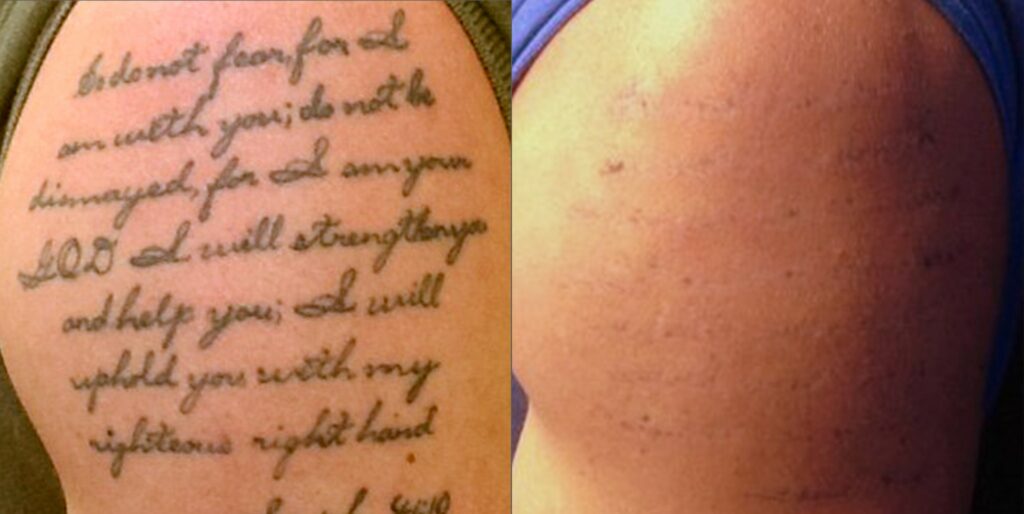
Fading Regrets is a company dedicated to helping those looking to bid goodbye to their tattoos. Our laser tattoo removal services have allowed many individuals from all walks of life the chance for skin and confidence renewal. Each individual’s story behind why they want their ink gone, be it due to displeasing design, personal sentimentality or parenting obligations, is varied yet unique in nature. Examples of our success can be found by viewing the ‘Before & After’ pictures featured on our website page called ‘Fading Regrets – Before and After Pictures’ which showcases great results achieved through removals enabled by us at Fading Regrets!
Will Tattoo Be Completely Erased by Laser
When it comes to laser tattoo removal, a question we often get asked is whether the process can erase tattoos completely. This typically varies from one individual to another – usually, complete erasure isn’t always guaranteed. Different elements such as dye color and tattoo pigment depth will affect this outcome – for example. Black or blue hued tattoos have proven receptive to treatment due to their higher absorption of light with lasers compared to colors like white/yellow/pink plus green, red and neon tones which are more difficult when aiming for full elimination.
Innovations in Laser Tattoo Removal Technology
Tattoo removal is a constantly growing field, with new methods and technologies being developed to make the process more efficient. A recent development has been the picosecond laser technology, which works by emitting light pulses in just one trillionth of a second- much faster than nanoseconds used in traditional lasers. This breaks down tattoo ink into smaller particles that are easier for the body to rid itself of it quicker and effectively remove tattoos. Non-invasive magnetic techniques have also emerged as an increasingly popular alternative due to their speedier nature while still providing minimal discomfort compared to other forms of tattoo removal procedures like laser technology.
Comparing Laser Tattoo Removal to Other Methods
Tattoo removal is commonly done through laser, but other methods are available. Surgical tattoo removal comes with a variety of side effects such as swelling, blistering, bleeding and the risk of infection. Cover-up tattoos involve covering up an existing design with new permanent ink to create a different design – this can be complicated if it’s intricate work. On the other hand, laser treatment has become accepted worldwide as one of the most successful techniques for removing unwanted body art in general terms including fading or fully erasing visible signs by way of targeted pulses beams fired from lasers onto pigmented areas on skin’s surface.
When to Consult a Professional
Removing a tattoo is an individual decision that should be made with care. If your current feelings towards the tattoo no longer match or it’s causing complications in job prospects, exploring professional tattoo removal lasers may be necessary. It’s essential to pick someone experienced and qualified for laser treatment – someone who has done similar successful procedures before as well obtained proper training about taking off tattoos, holds licensure/certification qualification regarding removals and can showcase their work through portfolios or even having had apprenticeship experience.
Top Frequently Asked Questions About Laser Tattoo Removal
Tattoo removal is a process that involves the use of laser technology, and this guide has hopefully helped address some common questions. There are still other frequently asked questions when it comes to tattoo removal via lasers such as scarring potentiality, pain levels during procedure sessions, using for revision purposes or changing designs on existing tattoos, costs associated with treatments, any adverse effects after healing post-treatment completion time requirements and exactly how the entire process works.
In order to provide more clarity around these issues regarding laser tattoo removals, we aim to share detailed information about each aspect within this guide. Acknowledging all doubts around precision procedures like laser tattoo elimination may help in making an informed decision related from its effectiveness down to precise pricing schemes based upon individual needs which makes them unique experiences according to many patients. Ultimately customers should understand every step involved with remove their unwanted tattoos before taking those brave steps into permanent body alterations!

Laser removal may require multiple sessions in order to fully remove tattoos, but this treatment can be done successfully for complete erasure.
Laser tattoo removal is a successful and safe way of eliminating unwanted tattoos. While this process may take several treatments, it has been confirmed that lasers are the best option for completely removing these types of body art. Laser tattoo removal really does work in getting rid of undesirable tattoos.
Getting a laser tattoo removal is usually less painful than getting the actual tattoo. It may feel like a snapping rubber band against your skin, or more comparable to an intense sunburn feeling.
When it comes to tattoo removal, an alternative is the use of lasers. Surgical, cover-up tattoos and other tattoo removal methods can be employed depending on your unique needs. Keep in mind these choices when making a decision as to which course of action you should take for removing unwanted body art.
Picosecond laser technology has revolutionized laser tattoo removal work as it is a highly important advancement in laser tattoo removal. This technology enables rapid and accurate treatment that can effectively treat cancer.
Remember, these answers are general guidelines. For personalized advice and consultation, it’s best to schedule a consultation with a professional at a laser clinic to discuss your specific tattoo and treatment plan.
Fading Regrets’ Top Resources on Tattoo Removal:
Complications of Tattoos
Health Canada on Cosmetic Laser Treatments
Tattoo Removal – MyHealth Alberta
Updated Guide on Laser Tattoo Removal

